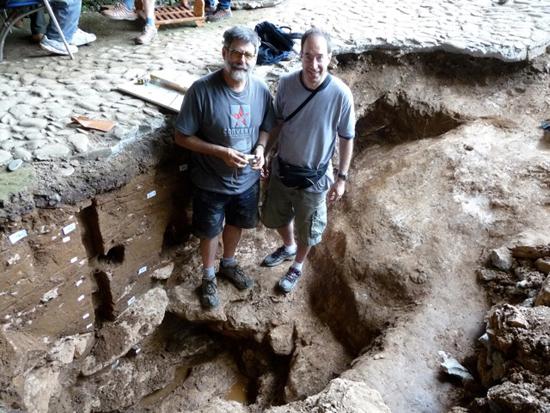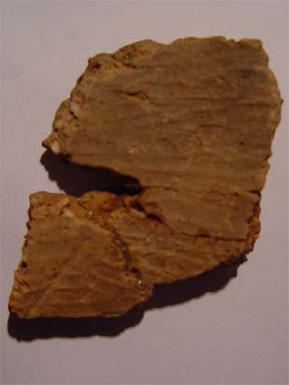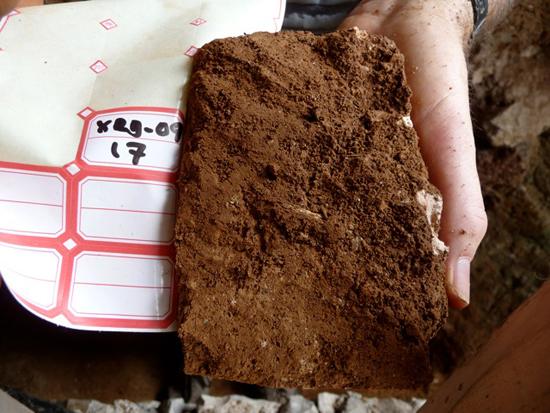BU lab confirms pottery find in China as world’s oldest
Rich Barlow / Boston University
Source - http://www.bu.edu/today/2012/a-prehistoric-pottery-barn/
 Paul Goldberg (left), a CAS archaeology professor, and David Cohen, an adjunct assistant archaeology professor, at Xianrendong Cave in China, where the the world's oldest known pottery was found. Photo courtesy of David Cohen
Paul Goldberg (left), a CAS archaeology professor, and David Cohen, an adjunct assistant archaeology professor, at Xianrendong Cave in China, where the the world's oldest known pottery was found. Photo courtesy of David Cohen
It sounds like glamorous science: confirming the discovery of the world’s oldest pottery. But for BU researchers, it meant looking for insect poop, among other things.
We’ll explain momentarily. Meanwhile, science is rethinking long-held beliefs about crockery’s use following the BU-aided discovery that humans crafted pots during Earth’s last ice age—about 20,000 years ago, two or three millennia older than previously known.
The findings, announced in a June paper in the journal Science, come from an international research team that included Paul Goldberg, a College of Arts & Sciences professor of archaeology, research associate Trina Arpin (GRS’04), and David Cohen, an adjunct assistant professor of archaeology.
The work joins a string of discoveries upending the conventional wisdom that pottery arose more recently—10,000 years ago—as humanity evolved from hunting-gathering to farming. The old theory held that when people developed agriculture and permanent settlements, they invented pots to cook vegetables and grains. That view already was looking like a crock, if you will, as scientists knew that the Chinese and Japanese had pottery about 17,000 years ago, says Arpin. “This discovery definitely pushed it back another 3,000 years. It’s really changing how people think about why people made pottery—what it’s used for.”

A pottery fragment found in a soil layer at Xianrendong cave is approximately 20,000 years old. Photo courtesy of Science/AAAS
The pottery shards in question came from the Xianrendong cave in south China, where archaeologists began excavating in 1961. The researchers dug up bone fragment–laced sediment where pottery remains had been found earlier. Goldberg’s Laboratory of MicroStratigraphy, the only such lab in the country, microscopically analyzes soils and sediments, and researchers there studied the sediment from Xianrendong to corroborate other scientists’ dating of the bone fragments.
The discovery “demonstrates that hunter-gatherers in East Asia used pottery for some 10,000 years before they became sedentary or began cultivating plants,” the researchers’ paper says. “Scorch and soot marks on exterior surfaces indicate that Xianrendong pottery likely was used for cooking,” but the authors note that other hunter-gatherer groups used pots for other purposes, such as food storage and brewing alcoholic beverages.
Researchers had speculated that the pot fragments found at Xianrendong were 20,000 years old, but they wanted their BU colleagues to confirm that the sediment layers had been stable and not disturbed. If the BU lab’s work showed the sediment was laid down 20,000 years ago, it would corroborate the shards’ age.
And that meant probing for things like bug poop. The presence of insect waste “tells you that you have a lot of insects burrowing in the sediment” and disturbing it, possibly displacing it from where it was originally deposited and throwing off estimates of its age, says Arpin. But the BU researchers found almost no bug-burrowing.

Sediment samples like this one collected from Xianrendong cave were microscopically analyzed to confirm the age of the oldest known pottery. Photo courtesy of David Cohen
Goldberg’s lab analyzed the sediment by drying a block of it in a 60-degree oven for several days. Then the block was hardened in a container of polyester resin (“similar to that used in fiberglassing a surfboard,” he says). The sample was allowed to gel for a few days and placed back in the oven overnight to complete the hardening. “We essentially turn a block of dirt into a rock,” Arpin says.
Researchers then cut the rock into thin slices with a diamond-embedded saw. Chips of the rock were further thinned (ultimately, to one-third the thickness of paper, according to Arpin) and examined under a microscope using up to 200-magnification, looking for “any abrupt change” in things like the mineral grains.
Goldberg says he introduced this kind of soil analysis to archaeology 35 years ago, and his lab is no stranger to mind-bending discoveries, having established that mankind had fire 200,000 years earlier than previously thought. But confirming that people were potters long before they were farmers, he says, rates as “a very gratifying contribution” of his career.
Arpin says the next step will be looking for similarly aged or even older sites. Meanwhile, Goldberg is off to other projects. At the time BU Today reached him in mid-July, he was teaching at a BU field school and working a site on a Spanish Mediterranean island. There and at other research projects in South Africa, Germany, France, and China, the globe-hopping archaeologist is studying how early sites formed by trying “to read the sediments as if they were artifacts themselves. So in the laboratory, we are studying 2,000-year-old sediments from houses here in Menorca to fireplaces from Neanderthal sites in France and Israel.”